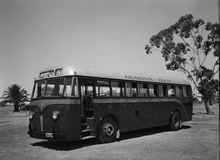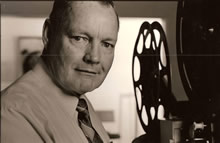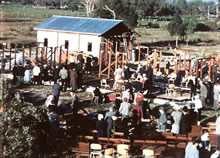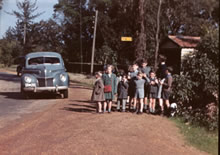
The Foothills Connection Community Heritage Project (1988-1990) is a rare example of a local government authority encouraging a community to collect its own history. [17] The Shire of Kalamunda Community Arts Advisory Committee, comprised of individual artists and community groups, invited the community to outline the types of art projects it would like to see developed.Out of ten potential projects, the Foothills Connection Project was given priority. [18]
The Foothills region was originally quite fragmented geographically and underwent a surge in development in the 1950s. Older citizens had seen the land around their local communities cut up into blocks for residential home sites. The new residents had difficulty feeling any sense of community in this period of rapid growth and change. This led to a loss of community identity. [19] Historically, residents in the Foothills region in the Shire of Kalamunda, including High Wycombe, Maida Vale, Forrestfield and Wattle Grove, struggled with the perception that they were poor relation to the neighbours 'up the hill' in Kalamunda and Lesmurdie. However, Foothills residents had their own history, community arts and activities that were distinct from other parts of the Shire and just as worthy of recognition. [20]
The main goal for the Project was to demonstrate 'in real terms to our senior citizens in the foothills the worth of their efforts in the early days, while simultaneously helping new residents feel that they belong from the outset'. [21] The community was involved in all of the decision-making about the Project which was co-ordinated by Iris Jones, the Community Arts Officer for the Shire. Curtin University's Centre for Australian Studies played an executive consultant role, providing training, documentation and ongoing expertise in the area of collecting local folklore. [22]
 The Kalamunda via Maida Vale bus
The Kalamunda via Maida Vale bus service, number 361, 1952.
Courtesy of the State Library of W.A.,
image ID 240387PD.
A pioneering aspect of the Project was its multi-faceted nature. It was 'the first time in Australia that a project of this breadth has attempted to delineate and document the history, folklore, community arts and crafts, visual record and essential sense of local identity'. [23]
Oral History Interviews
The Project broke new ground in using specialists to train volunteers from the local community to record their own history. Ten volunteers from the area were trained in the methodology of oral history collection by Ronda Jamieson from the Battye Library of West Australian History. The course was tailor-made to suit the Project with sessions being held over a six week period. Participants were specifically looking to bring out stories around folklore in their oral history interviews. Graham Seal from the Centre for Australian Studies demonstrated the importance of folklore in oral history so that volunteers knew what to look for and what to ask in the interviews. [24] More than 70 oral history interviews were recorded.
 Basil Archer, resident of the Foothills
Basil Archer, resident of the Foothills
area and interview participant, ca. 1988.
CUL00088/1/2.
Music
Roger Montgomery was hired as the Project's musician-in-residence with a brief to collect and stimulate local music making activities. [25] The music-related activities provided insight into popular recreations in the area, for example in the 1920s 'the Saturday night dance was the highlight of the social calendar and the jarrah floors of locally constructed halls would be polished with anything abrasive, from sand to Weet-Bix'. [26]
Although there was not a great deal of folk music collected, Montgomery created his own music based on the collected local history and encouraged the community to write poetry about the Foothills in a competition promoted through the local newspaper, the Kalamunda Reporter.[27]
Montgomery discovered local poet Jack Sorensen's writings about the Foothills as well as the Goldfields and the Great North West through Sorensen's niece Lynette Sorensen. The poet and his work were better known and regarded in the East than in Western Australia and in the 1920s and 1930s his work was regularly published in the Bulletin. [28] Montgomery wrote music to complement some of Sorensen's poetry about the Foothills area.
As a result of the residency, the Project had collected a reasonable amount of local poetry and songs, many residents were more aware of their own area, the poetry group was strengthened in membership and several 'Foothills' nights were held at the Hills Folk Club. [29]
Photographs
Brent Sumner was appointed photographer-in-residence and worked with volunteers from the local camera club to research and create a visual record of the community. The photographs show changes to the region - scrub and sand became parks, new roads were built, and citrus orchards were developed into residential areas. [30] Sumner's brief was to collect historic images and to photograph contributors to the oral history interviews. He also involved members of the local camera club in re-working their photographs for possible future publication. [31]
Writing
British author and oral historian Nigel Gray was appointed writer-in-residence and provided editing, writing and desktop publishing skills to the community. [32] A key aim was to publish a book that included the oral histories of the Foothills and its folklore, collected music and a selection of collected photographs. [33] Although not formally published, the manuscript of the book is held in the State Library of Western Australia and is entitled Battlers in the sand, 1990: an oral history of European settlers in the foothills of the Kalamunda Shire.
 Inspecting the Welfare Centre
Inspecting the Welfare Centre
Foundations and layout at
Wattle Grove Baptist Church, n.d.
Original held by
the Kalamunda
Public Library
Local History Collection. CUL00088/1/3.
Support for the Project
The Project received funding from a diverse range of sources including the National Library of Australia, the State Library Board of WA, the Literary Arts Board, the Community Cultural Development Unit of the Australia Council, the Western Australian Department for the Arts, the Australian Folk Trust, the Shire of Kalamunda and a number of private sponsors. Additional support from the Australian Folk Trust and Myer Foundation facilitated the transcription of the oral history interviews. [34]
Planning and consultancy support was provided by Curtin University's Centre for Australian Studies. Many local groups were also involved, including the Hills Folk Club, the Hills Branch Fellowship of Australian Writers, the Foothills Camera Club, the Foothills Learning Centre, Wordflow (the Foothills poetry group) and the Kalamunda and Districts' Historical Society. [35]
Interviews conducted for the Foothills Connection Project
This series comprises synopses, transcripts and audio recordings of approximately 75 oral history interviews conducted by residents of the Foothills region. The subject areas covered include: childhood, transportation, marriage, farming, schooling, migration, familly life, home remedies, the Depression years, religion, local associations, gardening, poetry, racism, social life, community work, recreation, superstitions, ghost stories and medicine.
View the series record in the digital archive where you can look at the files and items relating to this series.
Photographs collected for the Foothills Connection Project
This series includes photographs relating to the oral history interviews of residents in the Foothills region of the Shire of Kalamunda. The photographs include images of the interview participants and historical images of the Foothills area and its residents provided by the interviewees.
View the series record in the digital archive where you can look at the files and items relating to this series.
 Children on the way to Sunday School
Children on the way to Sunday School
at Forrestfield, Winter
1947.
Original
held by the
Kalamunda
Public Library
Local
History Collection. CUL00088/1/4
.
 |
||||||||